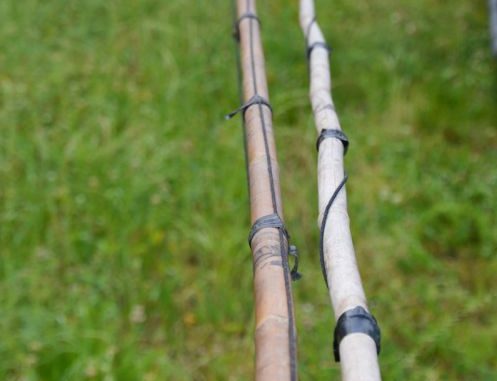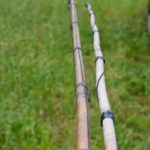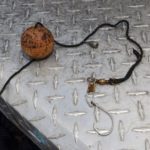
Fishing choupique the Lirette way is power fishing, and that starts with the poles.
“Some people fish for choupique with rod and reels. I don’t use them. I miss too many fish.” And Mike Lirette doesn’t like to miss fish.
So he and cousin Dale Lirette use something out of the past — Calcutta bamboo poles. I didn’t think you could even buy them anymore.
“Oh yeah,” replied Mike, “Thibodaux Feed & Seed sells them, and so does Wilson’s Kountry Korner off Louisiana Highway 20 going into Morgan City.”
Their poles weren’t dinky little bream poles. The men cut the tip end off of the poles down to where they were about a half-inch in diameter, making 12- to 14-foot poles. They looked more like pole vault poles than fishing sticks.
And the fishing line!
It certainly wasn’t vanishing fluorocarbon. Rather, it was black nylon trotline twine (#6 Mike thought).
Corks are a real issue for them. They use “old school” plain, round, natural cork floats — and they are big. “These are getting hard to find,” grunted Mike.
“And expensive, too. I paid $6.50 apiece for the last ones I bought,” moaned Dale.
I naively asked why they didn’t just use other corks.
Mike looked down his narrow Gallic nose as he answered me. “I don’t want no saltwater corks. I was raised freshwater. They work, but that’s not how I was raised.”
He snorted contemptuously at the idea of red and white plastic snap-on corks. “They break!”
I could understand that. This was brutal fishing.
Their hooks are 4/0 to 6/0 circle or kahle hooks. “We break a lot of straight (J) hooks,” explained Mike. “These don’t, and they hook fish better.”
After cutting off its tip, they rig a new pole by stringing a cork onto the nylon twine and then adding a weight below it. Mike uses a small bell sinker, while Dale employed an old time classic pinch-on sinker. The sinker is needed to drag the bait through the water plants down to where the fish live.
Then they tie an overhand loop on the end of the line. A turbo-sized snap swivel is looped on the loop and a hook is added to the snap swivel.
The point of the hook is temporarily, but securely, lodged in the butt end of the pole and the line is extended up the pole to its tip, where it is tightly tied. Then the line is run back down the pole and again securely tied near the butt before being cut from the spool.
The latter length of twine (running from the tip of the pole to its butt) is taped to the pole every 18 to 24 inches with electrical tape. The knots on the tip and butt are also taped over.
The rationale for the length of line taped down the pole is simple. “If the pole breaks, you still got the fish,” grinned Mike.
“Last year, I had one fish that broke my pole in three places,” verified Dale.
The pole is completed by setting the cork at the desired fishing depth and inserting its stopper stick.
“Make two or three poles,” advised Mike. “You would be surprised at how many they break.”




